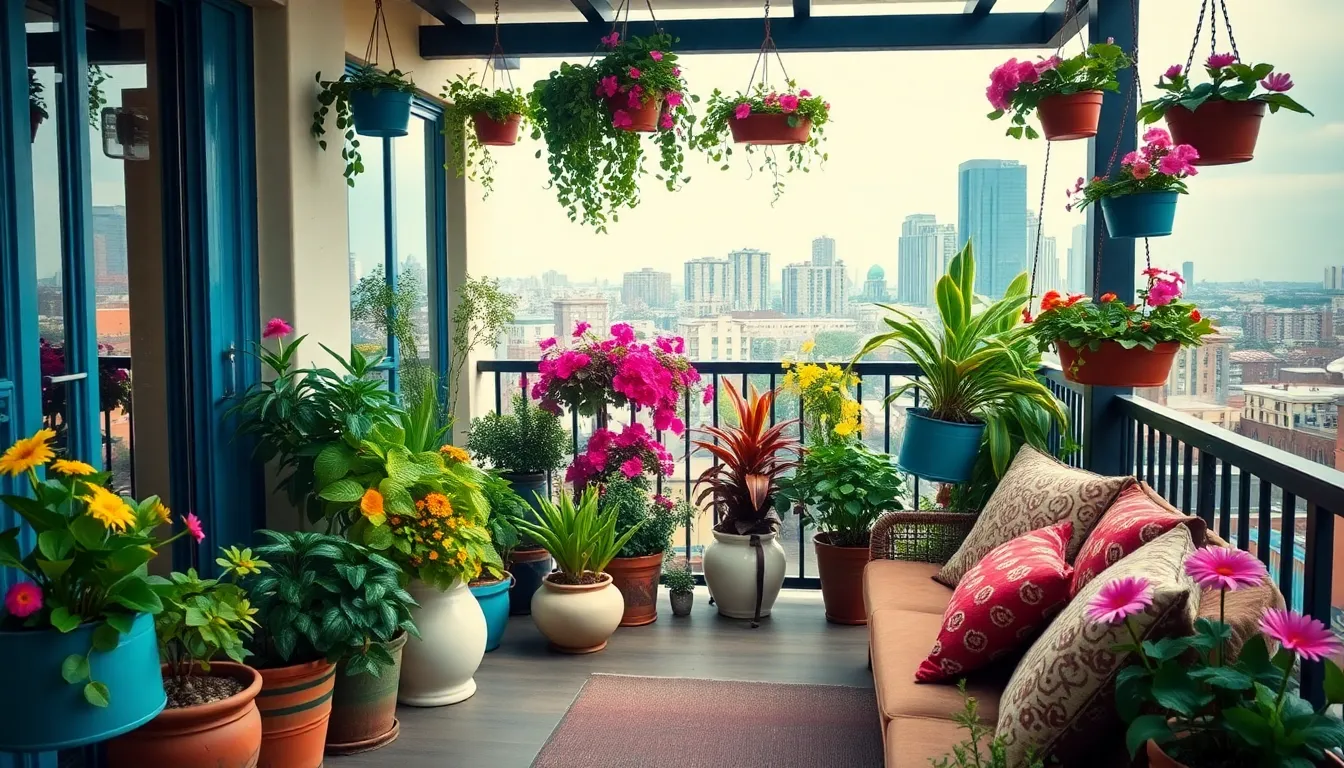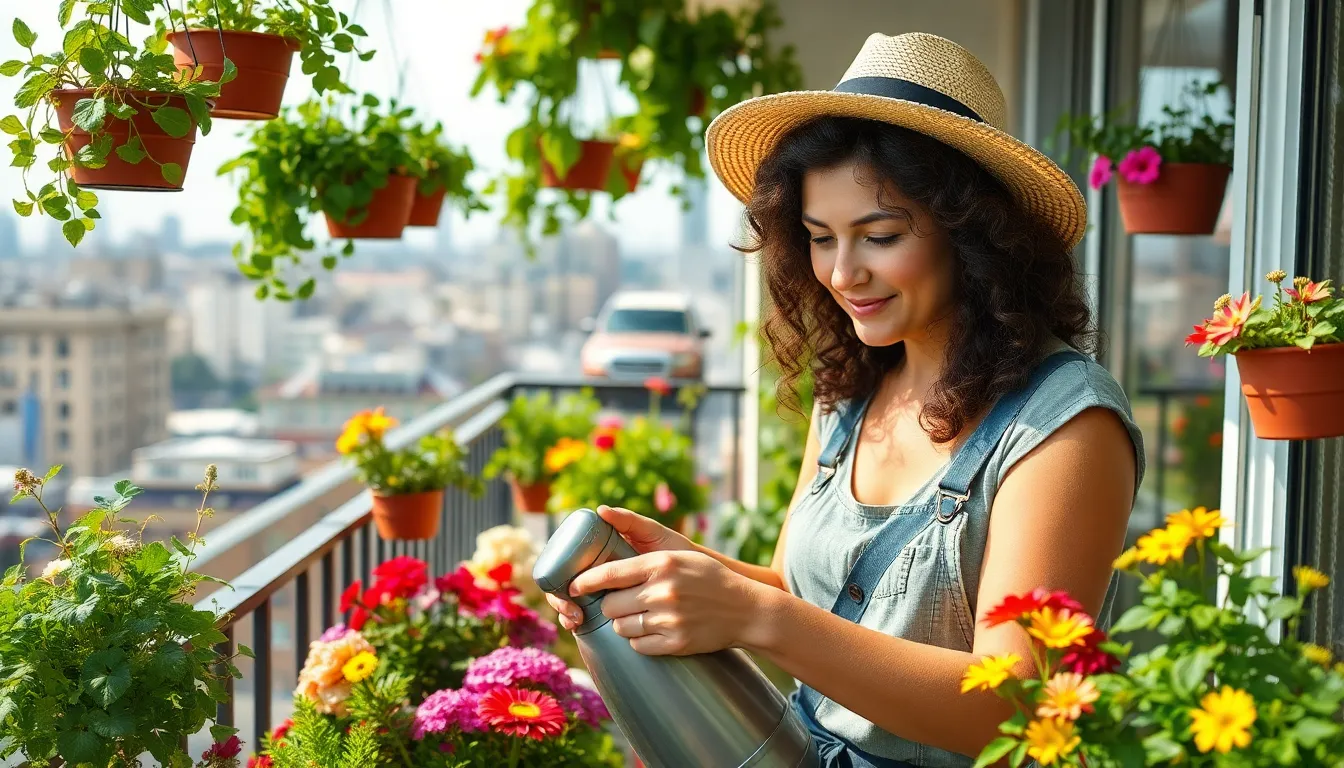Imagine stepping out onto your balcony and being greeted by a vibrant oasis of greenery, where fresh herbs and colorful flowers flourish in harmony. A balcony garden isn’t just a patch of plants; it’s a mini paradise that transforms dull outdoor spaces into lively retreats. With a little creativity and a sprinkle of care, anyone can turn their cramped balcony into a flourishing garden that even the most seasoned botanists would envy.
Table of Contents
ToggleOverview of Balcony Gardens
Balcony gardens offer a unique opportunity to bring nature into limited spaces. Such gardens can include flowers, herbs, vegetables, or ornamental plants. Fresh herbs like basil and mint thrive well and enhance culinary experiences. Colorful flowers brighten the environment, attracting pollinators and adding aesthetic value.
Various sizes of containers accommodate different types of plants. Small pots suit herbs, while larger containers support vegetables. Drainage is essential for plant health, preventing water accumulation that can lead to root rot. Utilizing lightweight materials eases the load on balcony structures.
Sunlight access is a critical factor in choosing plants. Most flowering plants need six or more hours of sun daily. Shade-tolerant options like ferns and some varieties of hostas work well in darker areas. Carefully selecting plants based on sunlight exposure maximizes growth potential.
Additional elements like vertical gardens or hanging planters enhance gardening space. Creating vertical displays optimizes limited areas while adding visual interest. These approaches promote lush greenery even in confined spaces.
Care routines for balcony gardens often require less time than traditional gardens. Regular watering, occasional fertilization, and pruning ensure healthy plant development. Observing plants closely helps identify early signs of pests or diseases, enabling quick intervention.
Overall, balcony gardens transform small outdoor spaces into green sanctuaries. With thoughtful planning and creativity, anyone can cultivate their miniature oasis. Embracing gardening in this format provides both beauty and a sense of accomplishment.
Benefits of Having a Balcony Garden

Balcony gardens offer numerous advantages, enhancing both lifestyle and environment. They contribute positively to personal well-being and the surrounding ecosystem.
Improved Air Quality
Plants naturally filter pollutants from the air, enhancing overall air quality. They produce oxygen, which benefits respiratory health. Balcony gardens also capture dust and harmful particles, reducing exposure to allergens. By incorporating flowering plants and foliage, individuals can create a cleaner living space. Studies show that indoor plants can decrease stress and improve cognitive function. Adding a variety of plants encourages biodiversity, promoting healthier urban environments. Through consistent care, balcony gardens become vital to maintaining fresh air in confined spaces.
Enhanced Aesthetics
Decorative plants and flowers significantly elevate a balcony’s visual appeal. Colorful blooms create an inviting atmosphere while offering a personal touch. Gardeners can arrange plants in visually pleasing configurations, maximizing beauty and interest. A well-maintained balcony garden acts as a charming retreat from busy lifestyles. Visitors often appreciate the aesthetic enhancement of such spaces, creating enjoyable experiences. Emphasizing unique plant combinations enriches the overall ambiance, turning ordinary balconies into vibrant sanctuaries. Observing the changes in growth brings joy, fostering a deeper connection with nature.
Choosing the Right Plants
Selecting the right plants significantly impacts a balcony garden’s success. Consider various factors such as sunlight, shade, and available space for optimal growth.
Sunlight and Shade Considerations
Sunlight access determines plant health and growth. Assess the balcony’s orientation to identify sun patterns. Most plants require 6 to 8 hours of sunlight daily; however, shade-loving varieties thrive in less. Inspect the walls and surrounding structures that might cast shadows. Plants that can adapt to partial shade include ferns and impatiens, perfect for these challenging spots. By wisely choosing plants based on light availability, gardeners can ensure a lush, thriving garden.
Types of Plants for Small Spaces
Choosing space-efficient plants maximizes balcony gardens. Consider compact varieties that flourish in containers. Herbs like thyme and rosemary yield culinary benefits while remaining small. For added color, opt for petunias and pansies, which display vibrant blooms without occupying much space. Succulents, including jade and echeveria, add charm and require minimal maintenance. Vertical plants such as climbing beans or sweet peas provide height while saving ground space. By selecting these plants, gardeners can create lush gardens even in the tightest spaces.
Designing Your Balcony Garden
Designing a balcony garden requires thoughtful planning and creativity. It’s crucial to optimize the available space for a vibrant display of plants.
Layout and Space Optimization
Maximizing layout enhances the garden’s functionality. Start by assessing the balcony’s dimensions and orientation. Choosing pots of various heights creates visual interest. Place taller plants at the back or along the sides to avoid overshadowing smaller species. Utilize vertical space with wall-mounted planters and trellises, allowing climbing plants to flourish. Integrate shelves to support herbs and small flowers, increasing overall plant capacity. Adopting a flexible layout makes rearranging straightforward; simply swap pots for seasonal blooms. Arranging plants based on sunlight requirements helps address varying growth needs. By considering these factors, gardeners can create a lush environment, transforming the balcony into a green retreat.
Tools and Materials Needed
Selecting the right tools simplifies gardening tasks. A sturdy set of hand tools, including a trowel, pruner, and weeder, enhances efficiency and effectiveness. Choose containers with adequate drainage holes to prevent waterlogging, promoting healthy root systems. Quality potting soil tailored for container gardening supports plant growth. Incorporating fertilizers and organic amendments fosters nutrient-rich soil. A watering can or hose with a nozzle ensures efficient watering, adaptable to different plant types. Additionally, investing in a gardening journal helps track plant progress and maintenance schedules. With these essentials, gardeners can cultivate a thriving balcony oasis, ensuring a satisfying and fulfilling experience.
Maintenance Tips for a Thriving Balcony Garden
Regular maintenance ensures a vibrant and healthy balcony garden. Focus on essential tasks like watering, fertilizing, and pest control.
Watering and Fertilizing
Watering plants consistently keeps them hydrated. Container gardens often require daily or bi-daily watering, especially in warm weather. Observing soil moisture is crucial; it’s best to water when the top inch of soil feels dry. Fertilizing should occur every four to six weeks during the growing season. A balanced liquid fertilizer promotes strong growth. Applying compost can enhance nutrient levels and improve soil health. Additionally, monitoring plant responses to watering and fertilizing helps optimize results.
Pest Control Strategies
Identifying pests early minimizes damage. Regular inspections of plants help catch any infestations. Natural predators like ladybugs effectively manage aphids and spider mites. Using insecticidal soap can treat common pests without harming beneficial insects. Neem oil acts as an organic pesticide, reducing populations of problematic insects. Encouraging biodiversity attracts helpful species; planting a variety of flowers supports pollinators and pest fighters. Maintaining cleanliness around the garden area prevents infestations from taking hold.
Creating a balcony garden offers a unique opportunity to enhance urban living. It allows individuals to cultivate a personal green space that promotes well-being and creativity. With thoughtful planning and the right plant choices, anyone can transform their balcony into a vibrant retreat.
Regular care ensures these gardens thrive, providing not only beauty but also a connection to nature. By integrating plants that suit specific light conditions and using vertical space wisely, gardeners can maximize their outdoor areas. Ultimately, a balcony garden serves as a delightful escape, enriching life with fresh herbs, colorful blooms, and the joy of nurturing living things.







